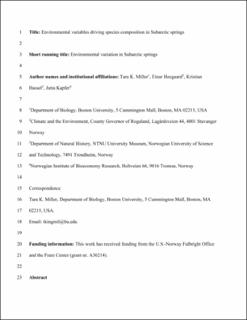Environmental variables driving species composition in subarctic springs in the face of climate change
Journal article, Peer reviewed
Accepted version
Permanent lenke
https://hdl.handle.net/11250/2754473Utgivelsesdato
2020Metadata
Vis full innførselSamlinger
- Institutt for naturhistorie [1225]
- Publikasjoner fra CRIStin - NTNU [38127]
Sammendrag
Questions Which environmental variables are most important in determining plant species composition in subarctic springs? Do observed patterns differ between typical wetland and general matrix‐derived species? Location Helocrenic (seepage) springs, Northern Norway. Methods We sampled 49 helocrenic spring sites, measuring environmental variables (water temperature, water pH, electrical conductivity, discharge volume, geographic position) and recording all species present. We performed a partial canonical correspondence analysis (pCCA) to determine the relative importance of water quality, spatial, and climatic variables for patterns in species composition and to compare the differences in these patterns between wetland and matrix‐derived species. Results We found that climatic and water quality variables were almost equally important in determining species composition in subarctic springs, with climatic variables explaining 26.62% of variation in species composition and water quality variables explaining 26.14%. Spatial variables explained the least variation (21.53%). When looking at the variables individually, altitude (10.93%) and mean summer temperature (9.25%) explained the most variation. The trend was the same for matrix‐derived species and wetland species, with climatic variables explaining the most variation (matrix‐derived: 27.26%; wetland: 24.42%), followed by water quality (matrix‐derived: 26.40%; wetland: 24.13%) and spatial variables (matrix‐derived: 24.87%; wetland: 16.27%). The main difference between matrix‐derived species and typical wetland species was that the spatial variables explained less variation for wetland species. Conclusions The close relationship of species composition (total vegetation as well as separated into wetland and matrix‐derived species) with climatic and water quality conditions indicates a sensitivity of subarctic springs to future climate change. In combination with altitude, which was found to be the most important individual variable, it is likely that the future distribution of spring species tracking climate change will be limited by the occurrence of suitable spring habitats, especially at high altitudes.
